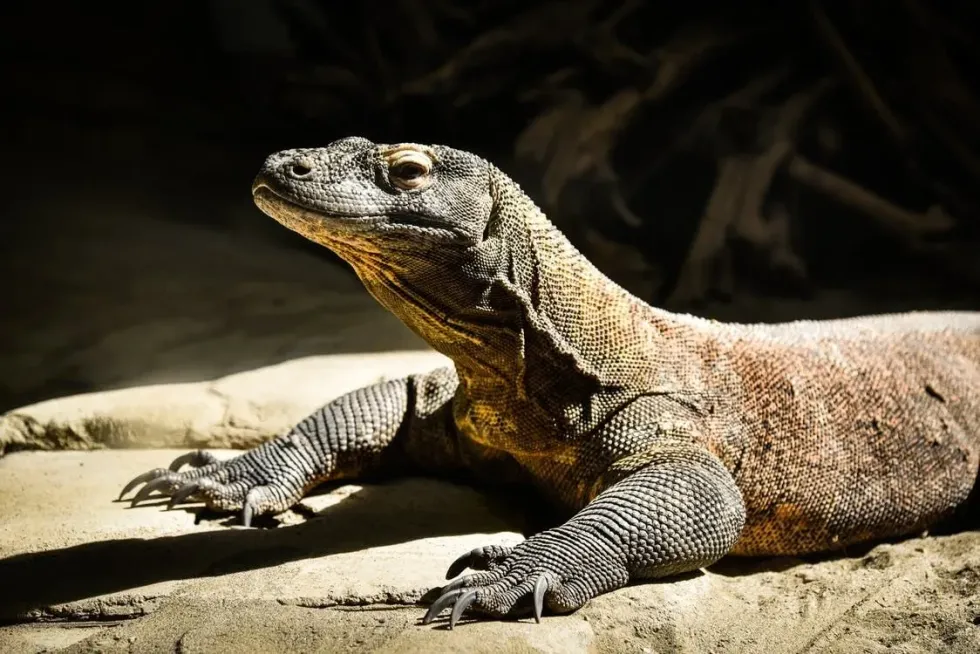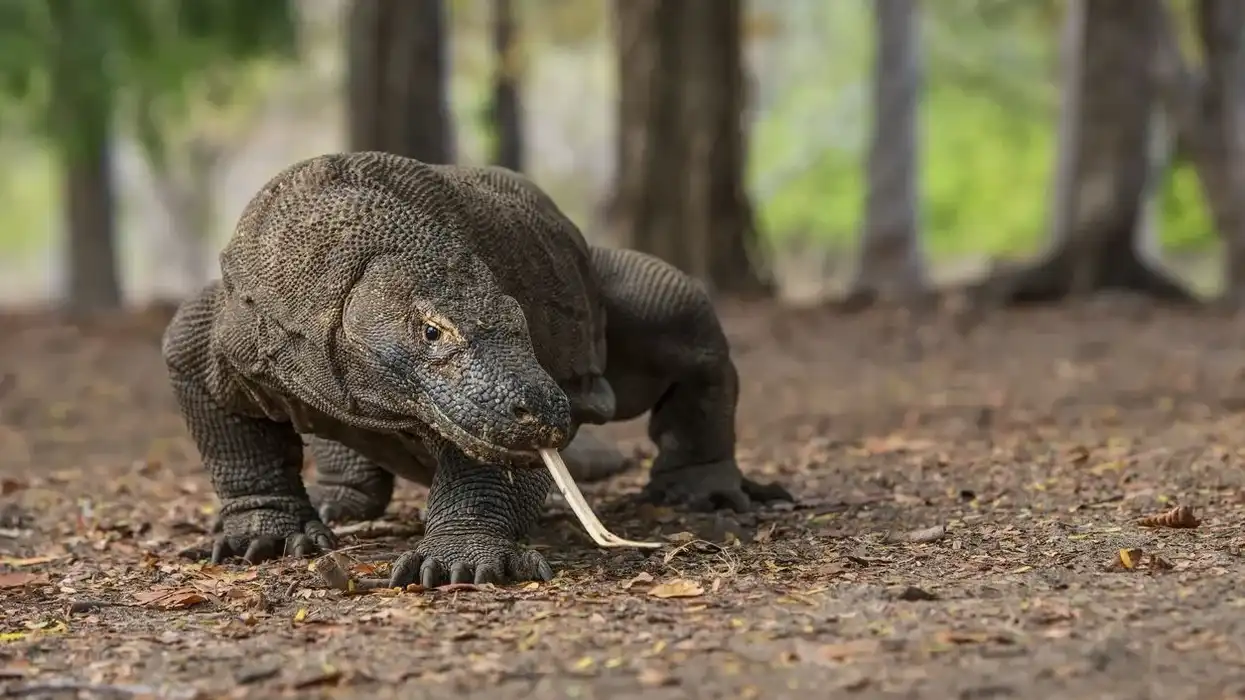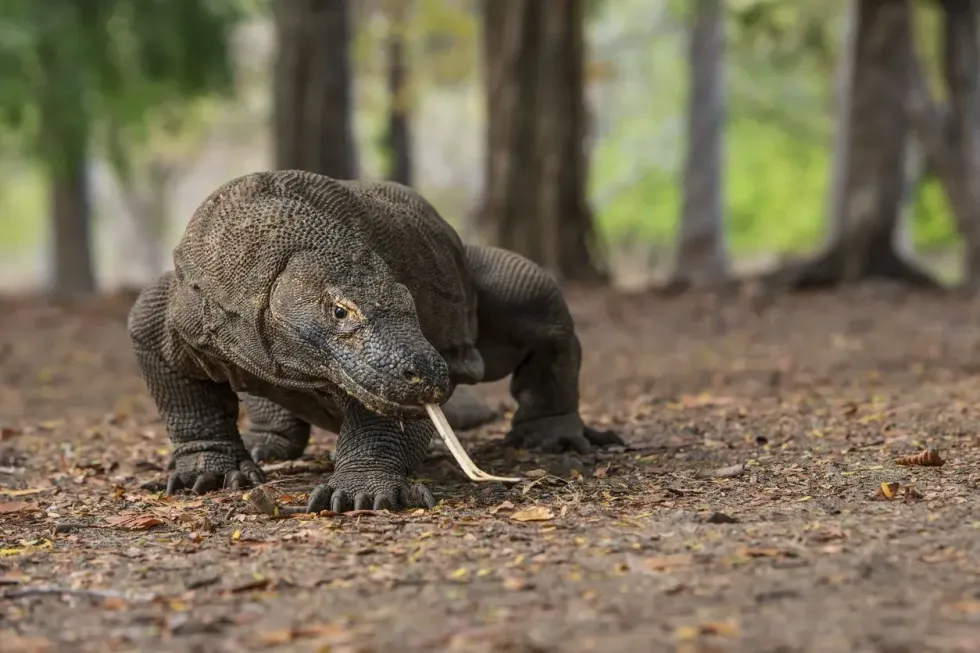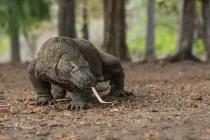Fun Komodo Dragon Facts For Kids
Content
- What type of animal is a Komodo dragon?
- What class of animal does a Komodo dragon belong to?
- How many Komodo dragons are there in the world?
- Where does a Komodo dragon live?
- What is a Komodo dragon's habitat?
- Who do Komodo dragons live with?
- How long does a Komodo dragon live?
- How do they reproduce?
- What is their conservation status?
- What do Komodo dragons look like?
- How cute are they?
- How do they communicate?
- How big is a Komodo dragon?
- How fast can a Komodo dragon run?
- How much does a Komodo dragon weigh?
- What are their male and female names of the species?
- What would you call a baby Komodo dragon?
- What do they eat?
- Do they bite?
- Would they make a good pet?
- Did you know...
- Can a Komodo dragon kill a human?
- Is the Komodo dragon endangered?
The Komodo dragon (Varanus komodoensis) is the largest living species of lizard in the world. They are native only to a few Indonesian islands, and that is the only place where you can find wild Komodo dragons.
They are also scattered in zoos worldwide, where they are kept in immense care. Komodo dragons are vicious predators. Another common name for this species is the Komodo monitor.
They are the dominant predators wherever they live: mostly because they have sharp claws and teeth and incredible body strength. A lot of animals fall prey to them. They can even hunt down water buffalo.
They are not only great predators but also are venomous. Their venom is powerful and can render their prey helpless once they bite them.
They are large and powerful, with a tail almost as big as their body. Their scales are hard and help keep them from injuries. If you want to read more interesting Komodo dragon facts and information like Komodo dragon venom facts, please read on.
If you like this article and want to read more about animals, read these interesting animal-related articles like the frilled lizard and the Caiman lizard.
Komodo Dragon Interesting Facts
What type of animal is a Komodo dragon?
The Komodo dragon, also known as the Komodo monitor, is a type of large lizards only found in some Indonesian islands. They are a species of large lizards called monitors.
Even though monitors can be found throughout Asia and Africa, Komodo dragons are native only to Indonesia, where they are housed in the Komodo National Park. The Komodo dragon scientific name is Varanus komodoensis.
What class of animal does a Komodo dragon belong to?
The Komodo Dragon belongs to the Reptilia family of the Animalia kingdom belonging to the order Squamata.
How many Komodo dragons are there in the world?
There are around 5,700 Komodo dragons left in the world. They are a vulnerable and protected species.
Where does a Komodo dragon live?
Wild Komodo dragons are exclusively found in some Indonesian islands. Komodo, Gili Montag, Flores, and Rinca are a few islands where you will find these lizards. The species gets its name from Komodo Island.
Komodo dragons like to live in hot and dry places. Savanna, tropical forests, and grasslands are their ideal living conditions. They thrive in the harsh Indonesian weather.
What is a Komodo dragon's habitat?
Komodo dragons are exclusive to the island of Komodo and a few other neighboring islands of the Lesser Sunda Islands of Indonesia. Though they live in tropical Savannah forests, the Komodo dragon habitat can range from the beach to the mountaintop.
The harsh weather conditions of these small islands do not seem to bother these giant lizards as they continue thriving there. There are some Komodo dragons in captivity around the world as well.
Who do Komodo dragons live with?
The Komodo dragon's tendency is to live alone. They are naturally solitary creatures that only come together for mating and sometimes eating. The adult Komodo dragons also show cannibalistic tendencies sometimes.
They prefer living and hunting alone. Though if a few Komodo dragons are sharing a territory, the bigger, more dominant males eat first, and the smaller ones eat later. It is a hierarchy they follow.
How long does a Komodo dragon live?
On average, the Komodo dragon's lifespan is about 30 years in the wild. Even though in captivity, their lifespan is a minimum of 30 years, they are known to live way longer than that. Scientists are still studying the lifestyle of these creatures to gather more data about their life cycle.
How do they reproduce?
Komodo Dragons have a very complicated and interesting reproduction cycle. The male Komodo Dragons fight amongst themselves to win the attention of the female. The winner gets to approach the female Komodo Dragon.
The mating is sort of a ritual for them. The females give off a scent that attracts the males towards them. When a male Komodo Dragon is attracted to a female, he will lick her body as a mating offer.
If she licks him back, they begin the mating process. After the mating is over, the female's litter size about 30 eggs. They bury them in the soil and wait for the newly hatched young Komodes to come out eight months later.
Even a few years ago, it was actually thought that Komodo monitors could only reproduce via mating. But it recently came to light that the females of the species can lay eggs without the intervention of a male. The process is called parthenogenesis.
But it has been observed that the offsprings that are born via this process are all males. However, to be able to give birth via parthenogenesis surely gives them an evolutionary edge. This might help them overcome the population problem one day.
The female Komodo dragons reach maturity at the age of nine years, while the males reach maturity at ten years. This is the age where they are mature enough to find a mate and begin their reproduction cycle.
What is their conservation status?
The IUCN (International Union for Conservation of Nature) has listed the Komodo Dragon as Vulnerable on their list.
According to CITES (The Convention of International Trade in Endangered Species of Wild Fauna and Flora), Komodo dragons are on the verge of extinction and are also affected negatively by international trade, and it is important to take steps for their conservation.
The main threat to Komodo dragons is humans sue to the loss of habitat due to excessive deforestation and poaching. The forest fires started by hunters to drive prey or poisoning of water are also one of the reasons behind the endangerment of Komodo dragons.
Loss of prey through illegal poaching is also one of the reasons why this species is on the verge of extinction.
Komodo Dragon Fun facts
What do Komodo dragons look like?

The Komodo dragon is the largest lizard alive on the planet. They can reach up to seven to nine feet in length.
The largest Komodo dragons sometimes reach just below 10 feet as well. The Komodo dragon's skull protects its large head, and they have large nostrils. They have a deeply forked tongue that is often yellowish in color.
Their tails are often as large as their bodies, and a lot of them can stand on their hind legs with the help of their strong tail. Their teeth are serrated and can measure up to one inch in length.
They have armored scales on their bodies that work as a natural shield to their bodies. These scales have tiny bones and are called osteoderms.
These osteoderms come in four different patterns and have different functions. But the rugged nature of their scales makes them unsuitable for leather goods. Only adult Komodo dragons have osteoderms, and they grow and change throughout their lives.
Their large claws help them in fights and while catching prey. Over time, the Komodo dragon adaptations have included changes to their skeleton.
Their ears are not very powerful, which makes their hearing restricted. They can see up to almost 1000 feet, but they have poor night vision.
Their tongue is their main source of sense, as they use it to both smell and taste. With the help of this tongue, they can detect carrion from a long way. They have a habit of swinging their heads from side to side while walking.
How cute are they?
Komodo dragons are vicious animals. They are also large and scaly. They do not qualify to be cute, unlike a few smaller lizard species. They are big with sharp teeth and claws intended for hunting.
They are also very strong and menacing. They are scary and dangerous, and it is best to avoid them if you do come across one in your life. Though they are not cute, the Komodo dragon's size, viciousness, and rarity attract tourists from all around the world.
How do they communicate?
Komodo dragons communicate mostly via body language. They cannot make loud sounds, but they hiss loudly and inflate their throats if they perceive a threat. They also use their tails to sweep their opponent off their feet.
Komodo dragons are known to fight amongst themselves for food and while mating. The males mostly fight amongst each other for dominance over food and females. Their sense of perception comes mostly from their incredible tongue that helps them smell and taste. Though they have good vision, they are mostly dependent on their keen sense of smell for survival.
How big is a Komodo dragon?
On average, male Komodo dragons are larger than female Komodo dragons. The average female Komodo dragon is 90 in (230 cm) long, while male Komodo dragons are over 100 in (260 cm) long. Male Komodo dragons also weigh more than female Komodo dragons. Komodo dragons that are kept in captivity tend to weigh more than those in the wild.
The largest Komodo dragon ever recorded was 10 feet (3 meters) long, and its body weight was around 366 lb (166 kg). Can you imagine a 10 foot Komodo Dragon?!
How fast can a Komodo dragon run?
Komodo dragons are not extremely fast runners, but they are known to sprint over short distances with average Komodo dragon speed. They can run up to 12 mph (20 km/h).
But they only run short distances. They are also good climbers and can climb trees and rocks. They are also great swimmers and can move through the water pretty fast.
How much does a Komodo dragon weigh?
The average adult Komodo Dragon weight is around 150 lb to 190 lb ( 70 kg to 90 kg). The adult male Komodo Dragons usually weigh more than the adult female Komodo Dragons.
The weight of the heaviest Komodo Dragon ever recorded was 366 lb (166 kg). Usually, Komodo Dragons that live in captivity weigh more than Komodo Dragons that live in the wild. The varied dangers and movements are the reason for that.
What are their male and female names of the species?
Both the adult male and female Komodo Dragons are called Komodo Dragons. They are also called Komodo Monitors in several places.
What would you call a baby Komodo dragon?
The baby Komodo dragons do not have a specific name. They can be called baby Komodo dragons, Komodo dragon younglings, or young dragons.
What do they eat?
Komodo Dragons eat carrion, and that is their main source of food. Through their extremely powerful sense of smell, they can smell carrions from over five miles away.
They are also known to prey on smaller mammals and birds. They can also collectively take down something as big as a water buffalo. The young of the species mostly feed on smaller lizards and snakes.
Komodo dragons have a very interesting hunting and digestive system. They often fight their prey and win because of their great strength. Their teeth can bite the prey, and their venom glands help them take down the prey completely. They are venomous, and their bites can be lethal if not treated.
A Komodo Dragon can eat 80% of its own body weight in one feeding and doesn't need to eat frequently. The rest to digest their food. They show exceptional group behavior while hunting even though they like to live solitary lives. There is a food hierarchy present in their world.
The strongest, most dominant males eat first. Then the less dominant males and females. The offspring eat after the adults are done.
Do they bite?
Komodo Dragons have a venomous bite that helps them in hunting. They have also been known to bite humans when threatened.
The Komodo dragon bite can be lethal. If you ever come across a Komodo dragon, it is best to run because Komodo dragon poison is pretty effective. Even if a human can get out of a Komodo dragon's grasp, their bite is often lethal to us.
Would they make a good pet?
Even though they are popular as exotic pets for whimsical people, it is best to not have a Komodo dragon as a pet. They are a protected species, and you can face legal charges if you own one. They do behave well in captivity, but they also have a biting tendency that makes them bad pets.
Did you know...
The Komodo Dragon's venom is very strong and can take down even a water buffalo.
Komodo Dragons have serrated teeth that are frequently replaced.
Komodo Dragons can go for a long time without food and water.
They are the largest extant lizards on this planet.
Komodo dragons have cannibalistic tendencies and often eat young Komodo dragons.
Young Komodo dragons usually live in trees to avoid contact with adult Komodo dragons in the fear of being eaten.
They belong to the large lizard species called monitors. They are also called Komodo monitors.
Even though nothing preys on Komodo dragons, it is estimated that anacondas could kill these large monitors as they are known to kill large lizards in their vicinity.
Komodo dragons may throw up on command to lessen their weight if they need to flee.
Can a Komodo dragon kill a human?
Even though a Komodo dragon attack is rare, it can kill a human. Komodo dragons have serrated teeth that can incapacitate even humans.
Their venom is powerful and can kill a human within hours of a bite. Their physical strength is also overwhelming for humans. The Komodo dragon saliva contains multiple strains of bacteria that are also extremely harmful to humans.
Is the Komodo dragon endangered?
Komodo dragons are listed as Vulnerable in the IUCN list. There are only around 5,700 of these monstrous lizards left in the world.
The reason behind this is mostly habitat loss and loss of prey. Deforestation for relocation and agriculture has left a lot of them without a home, and the poaching of hunting of their primary preys- deer, has also proved to be fatal to them.
They are also only found in the wild in five islands of the Lesser Sunda Islands of Indonesia, where many steps have been taken for their conservation.
Thus, they are only found in the wild in a very restricted area. They are mainly kept in the Komodo National Park on Komodo Dragon Island.
Here at Kidadl, we have carefully created lots of interesting family-friendly animal facts for everyone to discover! Learn more about some other reptiles including the olive ridley sea turtle and the desert tortoise.
You can even occupy yourself at home by drawing one on our Komodo dragon coloring pages.
We Want Your Photos!
More for You
Bachelor of Arts specializing in Journalism and Mass Communication, Postgraduate Diploma in Sports Management

Moumita DuttaBachelor of Arts specializing in Journalism and Mass Communication, Postgraduate Diploma in Sports Management
A content writer and editor with a passion for sports, Moumita has honed her skills in producing compelling match reports and stories about sporting heroes. She holds a degree in Journalism and Mass Communication from the Indian Institute of Social Welfare and Business Management, Calcutta University, alongside a postgraduate diploma in Sports Management.
Disclaimer
1) Kidadl is independent and to make our service free to you the reader we are supported by advertising. We hope you love our recommendations for products and services! What we suggest is selected independently by the Kidadl team. If you purchase using the Buy Now button we may earn a small commission. This does not influence our choices. Prices are correct and items are available at the time the article was published but we cannot guarantee that on the time of reading. Please note that Kidadl is a participant in the Amazon Services LLC Associates Program, an affiliate advertising program designed to provide a means for sites to earn advertising fees by advertising and linking to Amazon. We also link to other websites, but are not responsible for their content.
2) At Kidadl, we strive to recommend the very best activities and events. We will always aim to give you accurate information at the date of publication - however, information does change, so it’s important you do your own research, double-check and make the decision that is right for your family. We recognise that not all activities and ideas are appropriate for all children and families or in all circumstances. Our recommended activities are based on age but these are a guide. We recommend that these ideas are used as inspiration, that ideas are undertaken with appropriate adult supervision, and that each adult uses their own discretion and knowledge of their children to consider the safety and suitability. Kidadl cannot accept liability for the execution of these ideas, and parental supervision is advised at all times, as safety is paramount. Anyone using the information provided by Kidadl does so at their own risk and we can not accept liability if things go wrong.
3) Because we are an educational resource, we have quotes and facts about a range of historical and modern figures. We do not endorse the actions of or rhetoric of all the people included in these collections, but we think they are important for growing minds to learn about under the guidance of parents or guardians.







